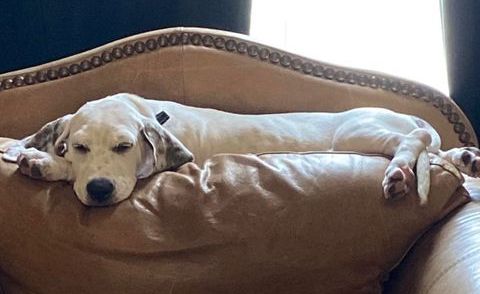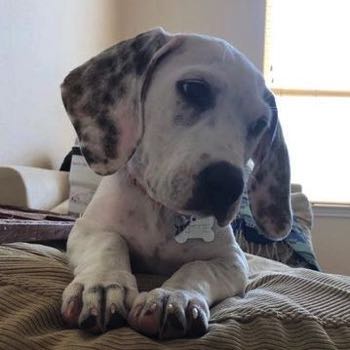Bully Basset

The Bully Basset is a hybrid dog, the result of breeding a Bulldog with a Basset Hound. As a blend of two breeds, their appearance may be a mix of both or lean more heavily to one or other of the parents. However, the Bully Basset tends to be stocky, sturdy, and stubborn, but with a loving nature.
If one word were the sum up the Bully Basset it would be ‘stubborn’ because this is strong-minded dog that puts their wishes above those of their owner. But this is traded against a placid, affectionate character with a distinctive presence that loves to be part of a family. However, this breed is not suited to first time owners and does best with an experienced dog handler.
About & History
As a hybrid breed the Bully Bassets story is relatively short and hazy. However, both parent breeds have long and venerable histories.
The Basset Hound
The Basset Hound originated from France as a variation on the long-legged St Hubert’s Hound, where their short legs had an advantage following a scent through low bushes. With noses close to the ground and a short stride, this made them popular with hunters on foot.
Originally Basset Hounds were popular with the French nobility, but after the French Revolution, the dogs were adopted by ordinary people. They prized the breed precisely because they could follow the dog on foot, rather than be mounted to keep pace. Bassets were introduced to the UK in the mid-19th century, but it took a couple of decades for them to become popular.
The Bulldog
The modern Bulldog, now a placid pet, is a different character to his distant ancestors. Back in the 16th century, Bulldogs were larger, athletic and aggressive. As the name suggests, this dog was inextricably linked to bulls and bull baiting.
After years of controversy, bull bating was made illegal in 1835. The bulldog, as an aggressive dog, lost their place in society and numbers dwindled. To survive, the breed was rehabilitated with the smaller, less aggressive animals being used to breed a line of dogs better suited as pets.
Appearance

The Bully Basset is a medium to large dog with heavy-set bones. They are something of a stretch-limo version of a bulldog, with the Bully Bassets often inheriting the longer back and snout of the Basset Hound, along with the heavy bones and barrel-like ribcage of the Bulldog.
The Basset's drop ears win out over the more rosebud Bulldog earflap, with Bully Basset pups having pendant ears falling to the jawline or below. That long nose also irons out those bulldog wrinkles, leaving a few residual frown-lines between the brows.
The Bully Basset has a short-haired, smooth coat, which is mostly white but with tan, fawn, or even lemon patches. And, with the Basset Hound having a long straight tail and the Bulldog a corkscrew tail, which wins out? The answer is usually a long straight tail predominates, which is something to wag about.
Character & Temperament
The Bully Basset is an amiable soul inclined to follow his own whims rather than listen to their owner. This stubborn trait means they are not a good match for inexperienced owners who may find them frustrating to train. However, this stubbornness is not born out of malice, so much as the knowledge that their strength and sturdiness puts them in a position of benign power.
Whilst the Bulldog isn’t a big barker, the Basset Hound has the hound trait of howling. This can incline them towards being noisy howlers. In addition, they like to chew and a wise owner provides an appropriate outlet for chewing, rather than letting the dog destroy the furniture. On the plus side, the Bully Basset is something of a gentle giant, and loves company and being part of a family.
Trainability

Like any juggernaut, ‘slow and steady’ is the motto when it comes to dealing with a Bully Basset. Reward-based methods are a must, because their innate strength means an owner is never going to win any physical battle. Indeed, patience, practice, and a consistent message are essential in order to train a Bully Basset, but do not expect the pieces to fall into place overnight.
Health
The Bully Basset is a hybrid dog and as such there are no statistics as to their health problems. However, the parent breeds do have well-known predispositions to disease, which are likely to show through in at least some of the pups.
Gastric Torsion
Gastric torsion, also known as bloat, is the result of the stomach flipping over on itself and sealing off the entrance and exit. This is a life-threatening condition as gas cannot then escape from the stomach which stretches like a balloon, sending the unfortunate animal into shock and organ failure.
The deep chest of the Bully Basset places them at risk of developing this condition. Prevention is extremely important, which includes feeding a good quality diet low in fermentable ingredients, feeding from a bowl on the floor, and always waiting at least one hour after eating before exercise.
Signs of bloat include the dog trying to be sick but not bringing anything up, and extreme restlessness as if in great discomfort. If you even suspect bloat may be a possibility, always phone a vet for advice.
Joint Disease
Both parent breeds have some degree of distortion to the bones of the limbs, such that the legs may be bowed and their weight spread unevenly. This places undue strain on the joints and can predispose them to damage joint surfaces, inflammation, and the development of premature arthritis.
To reduce the risk of damage it’s important not to over tire a growing puppy. Also a good quality diet designed for large breed growth, helps promote healthy bones and joint growth.
Allergies & Skin Disease
Both parent breeds have a predisposition to skin allergies and problems because of wrinkled skin. This leads to itchiness and self-trauma, which then sets up secondary skin infections.
Skin allergies cannot be cured, but there are effective options to control the symptoms and give the dog relief from the misery of constant itchiness. In addition, keeping the skin clean and carefully wiping out skin folds helps reduce the frequency of skin infections.
Von Willebrands Disease
This inherited condition means the dog lacks the vital Von Willebrand’s clotting factor in their blood. When injured, they are not able to form a stable blood clot and so even a minor injury may continue to bleed for long periods of time.
Again, there is no cure for Von Willebrand’s disease, and it’s important that affected dogs don’t take unnecessary risks and any surgery carefully thought through.
Entropion & Ectropion
Entropion is the in-turning of eyelids, whilst ectropion refers to droopy eyelids. This is significant because in-turned eyelids are a constant source of irritation each time the dog blinks, whilst out-turned eyelids expose the surface of the eye to excessive drying.
Surgical correction is possible to improve the eyelid shape. However, affected dogs should not be bred from, as they will pass the trait onto their pups.
Exercise and Activity Levels
Despite their long-lost working roots, neither parent breed is particularly athletic. The Bully Basset reflects this in that they do need regular walks and play, but once home, are content to curl up and snooze. They also prefer to walk or amble, rather than run, which makes them good to stroll with, but not recommended for an active owner wishing to jog with their dog.
Grooming
Don’t be deceived by that short coat, because although these dogs don’t need parlour trips for clipping, they do shed heavily and need regular brushing. It’s a good idea to give the pet a daily brush over with a wire-bristle or slicker in order to capture that shed hair and prevent it sticking to soft furnishings.
Their relatively low exercise requirements can make them prone to overlong nails. Get the pup used to having their paws and claws handled from an early age, so they co-operate with nail trimming as an adult. In addition, daily tooth brushing is strongly advised to reduce the risk of dental disease.

